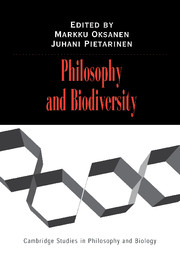Book contents
- Frontmatter
- Contents
- List of Figures and Tables
- List of Contributors
- Acknowledgements
- Philosophy and Biodiversity
- Part I USING ‘BIODIVERSITY’
- Part II UNDERSTANDING BIODIVERSITY
- Part III VALUING BIODIVERSITY
- Part IV PROTECTING BIODIVERSITY
- 10 Biological Diversity and Conservation Policy
- 11 Beavers and Biodiversity
- 12 Differentiated Responsibilities
- Index
- References
11 - Beavers and Biodiversity
The Ethics of Ecological Restoration
Published online by Cambridge University Press: 26 June 2009
- Frontmatter
- Contents
- List of Figures and Tables
- List of Contributors
- Acknowledgements
- Philosophy and Biodiversity
- Part I USING ‘BIODIVERSITY’
- Part II UNDERSTANDING BIODIVERSITY
- Part III VALUING BIODIVERSITY
- Part IV PROTECTING BIODIVERSITY
- 10 Biological Diversity and Conservation Policy
- 11 Beavers and Biodiversity
- 12 Differentiated Responsibilities
- Index
- References
Summary
BIODIVERSITY AND ECOLOGICAL RESTORATION
Ecological restoration has been portrayed recently as a process capable of reversing the loss of natural biodiversity now occurring in many densely populated areas and intensively managed landscapes in Europe (Throop 1997; Hobbs and Norton 1996). Species restoration schemes operate throughout Europe and in parts of North America as well. For example, they have involved the lynx in Poland, and the wolf and the moose in New York State. Human subsistence activities, such as hunting and agriculture, have resulted in losses of wildlife species. Natural environments have been intensively utilized for many centuries, especially in Western Europe and parts of North America; and a high level of productivity characterizes these domesticated environments (Nash 1989). As a result of these efforts to transform the natural environment into a highly efficient growth medium, variation is lacking and natural biodiversity has declined.
Species have died out regionally, and their opportunities to return to former haunts have been seriously limited by intensive management of the natural environment (Thomas 1992). Moreover, artifacts such as roads, towns, and bridges, as well as the straightening of rivers, block the paths of migrating wildlife. New policies on the conservation of wildlife, and on the general management and protection of the natural environment, are pursued in many affluent industrialized countries. These aim to recreate and maintain the dynamics and variation of natural ecosystems (Kane 1994; OECD 1999). This presents new opportunities for the conservation discipline (Pickett and Parker 1994).
- Type
- Chapter
- Information
- Philosophy and Biodiversity , pp. 217 - 236Publisher: Cambridge University PressPrint publication year: 2004
References
- 8
- Cited by



